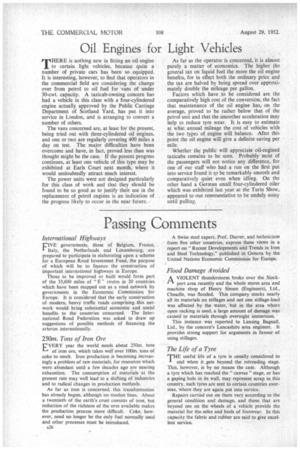Passing Comments
Page 28

Page 29

If you've noticed an error in this article please click here to report it so we can fix it.
International Highways FIVE governments, those of Belgium, France, Italy, the Netherlands and Luxembourg, are prepared to participate in elaborating upon a scheme for a European Road Investment Fund, the purpose of which will be to finance the construction of important international highways in Europe.
Those to be improved or built would form part of the 33,600 miles of " E" routes in 20 countries which have been mapped out as a road network by governments in the Economic Commission for Europe. It is considered that the early construction of modern, heavy traffic roads cornprising.this network would bring substantial economic and social benefits to the countries concerned. The International Road Federation was asked to draw up suggestions of possible methods of financing the arteries internationally.
250m. Tons of Iron Ore VERY year the world needs about 250m.. tons of iron ore, which takes well over 100m. tons of coke to smelt. Iron production is becoming increasingly a problem of raw materials, for resources which were abundant until a few decades ago are nearing exhaustion. The consumption of materials at the present rate may well lead to a shifting of industries and to radical changes in production methods.
As far as iron is concerned, this transformation has already begun, although on modest lines. About a twentieth of the earth's crust consists of iron, hut reduction of the richness of the ores available makes the production process more difficult. Coke; however, need no longer be the only fuel normally used and other processes must be introduced.
A26 A Swiss steel expert; Prof. Durrer, and technicians from five other countries, express these views in a report on "Recent Developments arid Trends in Iron and Steel Technology," published in Geneva by the United Nations Economic Commission for Europe.
Flood Damage Avoided
A VIOLENT thunderstorm broke over the .StockI—I port area recently and the whole stores area and machine shop of Henry Simon (Engineers), Ltd., Cheadle, was flooded. This company stocks nearly all its materials on stillages and not one stillage-load was affected by the water, but in the area where open racking is used, a large amount of damage was caused to materials through overnight immersion.
This instance was reported to Lansing Bagnall, Ltd., by the concern's Lancashire area engineer. It provides strong support for arguments in favour of using stillages.
The Life of a Tyre
THE useful life of a tyre is usually considered to I end when it ..gets beyond the retreading stage. This, however, is by no means the case. Although a tyre which has reached the "canvas" stage, or has a gaping hole in its wall, may represent scrap in this country, such tyres are sent to certain countries overseas, where they are again put into service.
Repairs carried out on them vary according to the general condition and damage, and those that are beyond use on the wheels of a vehicle provide the material for the soles and heels of footwear. In this capacity the fabric and rubber are said to give excellent service.
Piping Times
nN a certain stretch of Sussex road, constantly flooded in winter rains, sections of concrete drain piping were recently dumped along the edge of a recreation ground near which the flooding occurs. Drivers, noting this, have been wanting to pat the local surveyor on the back for tackling the problem during the summer. Unfortunately the local children have deserted the swings and seesaws, realizing that the pipes make splendid rocking-horses and can be used for a variety of circus tricks, resulting in the destruction of several sections.
It is reported that the surveyor now wants to pat the children on the back!
The Design of Rubber Bellows
THE rubber bellows used with vacuum-braking sys tems looks innocent enough, but its design governs the efficient operation of the braking system. A most important feature is that the bellows starts to move immediately the vacuum-control valve is operated, giving a minimum of time lag in brake application. The section of the rubber and the shape of the bellows are important design features, whilst the sealing means at each end are equally so. What may not be generally known is that such bellows can be obtained only through Feeny and Johnson, Ltd., of Wembley, makers of the F and J vacuum-braking equipment in which this device is used.
Lighting both Kerbs
DURING a visit to a seaside resort, a representative of "The Commercial Motor" observed an unusual dual fog or spot-light on a passing vehicle. The lamp was in the shape of an equilateral triangle, with the two lenses almost meeting at the apex, which was towards the front. The beams would appear to be directed at approximately 45 degrees from the centre line of the vehicle.
A lamp of this type would seem to be highly efficient whether the vehicle was driven on the left or right side of the road It would not bc likely to dazzle oncoming drivers, at least on a straight road. • It was not possible to ascertain whether or not there were independently wired bulbs.




















































































